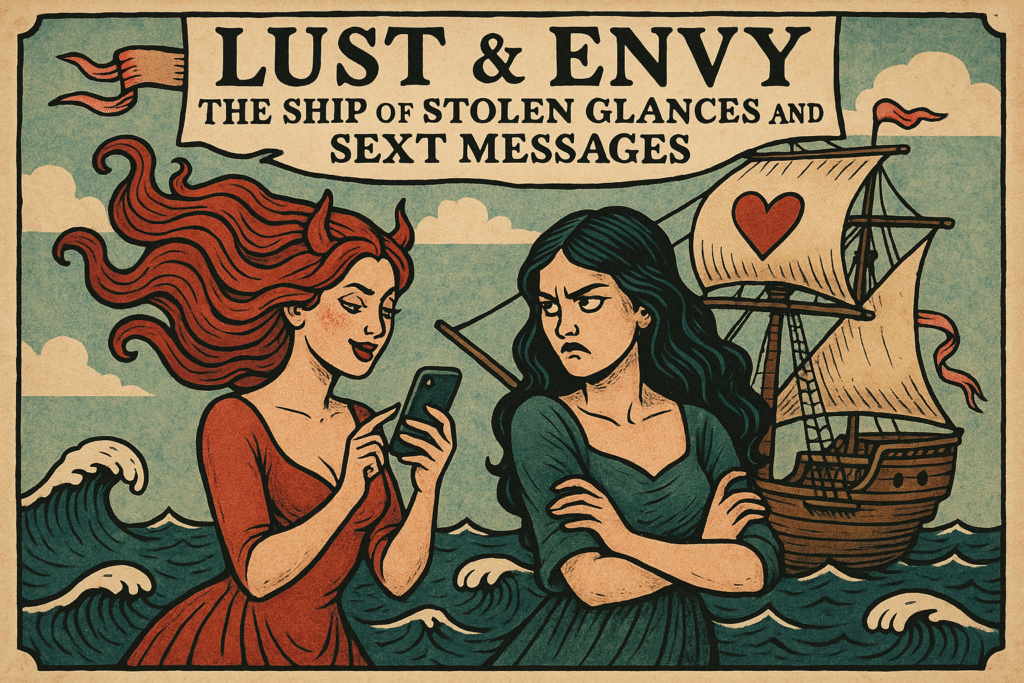Introduction: The Floating Petri Dish
The modern cruise ship is sold as a paradise of convenience, a floating city where every desire is anticipated and every comfort provided. It is a meticulously engineered escape from the mundane, offering serene sunsets, gourmet dining, and a temporary reprieve from the rules of the real world. Yet, beneath this glossy veneer of curated perfection lies a far more fascinating and chaotic reality. When thousands of strangers are placed in a self-contained environment, removed from the constraints of their daily lives and fueled by vacation-mode abandon, the vessel transforms into a unique social experiment—a floating petri dish for the full, unvarnished spectrum of human behavior.
For every postcard-perfect moment, there is a story that never makes it into the brochure. For every tranquil day at sea, there is a “WWF brawl” erupting in the atrium, complete with spectators on the upper decks cheering and throwing their drink glasses into the fray. For every dip in the pristine, adults-only pool, there is the discovery of what one passenger grimly described as a “huge turd,” a “torpedo” launched not by a child, but by a fellow adult, prompting an emergency draining of the pool as maintenance crews argued over the evidence.
This is the unfiltered world of cruising, a liminal space where social norms are not just relaxed but often abandoned entirely. The combination of anonymity, a finite timeframe, and an all-inclusive atmosphere where food and drink flow endlessly creates a psychological landscape that lowers inhibitions to a staggering degree. The stories that emerge from this environment—of bizarre behavior, shocking emergencies, and hilarious mishaps—are not mere anomalies. They are the predictable, and often spectacular, outcomes of the very fantasy the cruise lines sell: an escape so total that it untethers people from the common decencies that govern life on land. This is a voyage into that madness, a collection of the wildest, funniest, and most unbelievable tales from the high seas.
Part I: The Seven Deadly Sins at Sea
The enclosed world of a cruise ship, with its promise of limitless indulgence, often becomes a stage for the most primal human impulses. The traditional framework of the seven deadly sins provides a surprisingly apt lens through which to view the common threads of passenger misbehavior, revealing the motivations and consequences that play out daily between the buffet line and the lido deck.
Gluttony – The Buffet as a Battlefield

Nowhere is the breakdown of social order more evident than at the all-you-can-eat buffet. It is here that the psychology of abundance collides with basic decorum, transforming a casual dining experience into a theater of primal desire. The transgressions go far beyond simply overfilling a plate. One passenger witnessed a woman plunge her bare hands directly into a buffet serving bowl of whipped cream, forgoing utensils entirely in a moment of pure, unadulterated consumption.
This disregard for shared space and hygiene is a recurring theme. Another cruiser watched in disbelief as a woman took an individually plated dessert from the buffet, had a bite, decided she disliked it, and then placed the half-eaten item back on the line for the next unsuspecting guest. In a similar vein, a passenger was seen cutting in line with her used plate to return extra food to the communal serving bin, explaining that it “should not go to waste”. The buffet becomes a space where personal desire—to try a dessert, to not be wasteful—overrides any sense of public health or consideration for others.
The behavior extends beyond the buffet itself. One family’s son dropped a plate of chicken wings on the floor. When another passenger tried to inform the parents, she was told to “f*** off,” after which the family proceeded to eat the floor-seasoned wings. Perhaps most bizarre was the couple observed in the main dining room who, with each course, would chew a few bites of food, spit the masticated remains back onto their plates, and then await the next course, repeating this ritual every single day of the cruise. The buffet, and dining in general, serves as a microcosm of the broader cruise experience. The anonymity and perceived lack of consequences foster a suspension of the social contract, revealing a fundamental tension between individual gratification and collective responsibility that echoes throughout the ship.
Wrath – Atrium Brawls and Lido Deck Haymakers

When tempers flare at sea, they often do so with theatrical violence. The unique environment of a cruise ship can turn minor disagreements into full-blown “cruise rage,” with the vessel’s very architecture amplifying the conflict into a public spectacle. One of the most shocking and frequently reported incidents is the atrium brawl. A passenger described a fight that started between a few people at the atrium bar and quickly escalated into a “full blown WWF brawl” involving 10-15 people, with fists flying and glasses shattering.
What makes these events particularly surreal is the audience participation. The open design of a ship’s atrium, with its multiple decks overlooking a central space, transforms a private conflict into a gladiatorial event. As the fight raged below, passengers on the upper decks began cheering and, in a shocking escalation, started throwing their own drink glasses down at the brawlers. The physical separation and height difference create a psychological disconnect, allowing spectators to feel as though they are watching a performance rather than a dangerous assault. This detachment lowers their inhibitions, turning them from passive bystanders into active and destructive participants. The ship’s environment, combined with alcohol, can foster a rapid and dangerous mob mentality. Indeed, such brawls are reportedly so common on certain lines that some passengers sardonically refer to them as a “natural occurrence,” akin to watching a sunset.
The violence isn’t confined to the atrium. One cruiser witnessed a wife catch her husband making out with another woman on the lido deck at 1 a.m. She immediately started “throwing haymakers” at him while the other woman sat horrified. The next morning, the married couple was thrown off the ship. In another instance, a woman in the ship’s theater became so enraged by people whispering in the row ahead of her that she went “ballistic,” beating up multiple men and women and bringing the show to an abrupt halt. These outbursts reveal how the confined, often alcohol-soaked, atmosphere of a cruise can act as a pressure cooker for human emotion.
Lust & Envy – The Ship of Stolen Glances and Sext Messages

The cruise ship operates as a fantasy space, a temporary reality where passengers feel they can explore alternate versions of themselves. This “moral holiday” often leads to a collision between fantasy and reality, resulting in awkward, comical, and sometimes scandalous entanglements. At a shared Christmas dinner table, one passenger was stunned when a drunk woman asked for technical assistance with her phone so she could sext her high school boyfriend, who was still happily married and, according to her, very upset about the stream of photos he had just received during his own family dinner.
The pursuit of romance, or something like it, can take even stranger forms. At the martini bar, a man calling himself a dentist kept telling people he had his “equipment up in the room” if they needed their teeth worked on, earning him the nickname the “Love Dentist”. Meanwhile, crew members observe the full spectrum of these dalliances, noting that they see everything, including passengers “doing some bed wrestling with somebody that isn’t your husband or your wife”.
Sometimes, the mishaps are less about infidelity and more about simple embarrassment. One newlywed couple wore matching white bathing suits, only for the bride to discover in the hot tub that the combination of water and fabric rendered her suit completely transparent. These stories highlight the psychological impact of being “at sea”—literally and figuratively unmoored from one’s normal life, identity, and, occasionally, one’s better judgment.
Pride – The Kingdom of the Entitled

The “customer is always right” ethos of the service industry, combined with the marketing of cruises as perfectly curated experiences, can foster a staggering level of passenger entitlement. The demands and complaints that arise from this mindset often defy logic and reason, revealing a profound disconnect from the real world.
On embarkation day, a woman stormed up to guest services in a fury, demanding a full refund. Her complaint: there was a large crane visible from her sea-view stateroom window. A representative calmly explained that the crane was on the shore and would, in fact, stay behind when the ship departed. The passenger was left speechless. Another guest, having discovered a Michelin-star restaurant in a city not on their itinerary, demanded that the captain alter the ship’s course to make an unscheduled stop, insisting it was “on the way”.
This expectation that the world itself should bend to the cruise itinerary extends to nature. A group of passengers formed an “angry mob” at guest services, claiming their children were traumatized and demanding compensation because, during a whale-watching excursion, they witnessed an orca eating a seal. The marketing of cruises as all-inclusive, hermetically sealed theme parks creates an expectation of total control. When the messy, uncontrollable real world intrudes—be it a dockside crane or the food chain in action—it shatters this illusion, leading to outrage. The most bizarre requests are simply the logical endpoint of a promise that a passenger’s every whim will be catered to, including asking the crew what time the 24-hour buffet closes or when the Northern Lights will be “turned on”. One guest even took a crew member’s sarcastic joke about helicopters transporting the crew to a hotel each night as fact, returning the next day to demand compensation for the noise that kept her awake.
—To be continued—
